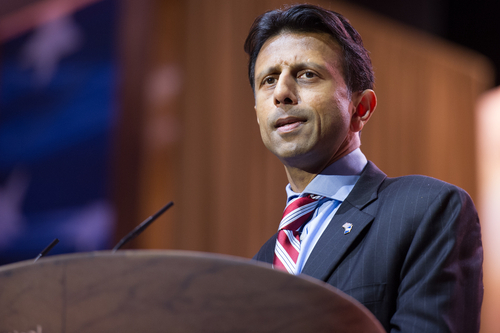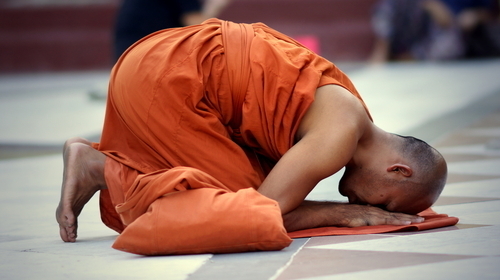Hemant Mehta's Blog, page 1844
December 19, 2014
“Jesus is the Reason for the Season,” Baptist City Council Member Reminds Jews at Menorah-Lighting Ceremony
The city of Springfield (Massachusetts) held it’s annual menorah-lighting ceremony to mark the first day of Hanukkah this past Tuesday. Among the 150 attendees was Springfield City Councilor Bud Williams.
While Williams is a Baptist, he decided to offer his own reflections on the Jewish holiday:
Jesus is the reason for the season.
Now, you might think this was bizarrely out of place at a celebration for the Jewish Festival of Lights. And you’d be right.
Williams, at any rate, thought it was all pretty reasonable and well done.
“Jesus was Jewish,” Williams said. “To me, Jesus is the messiah … I thought I was being very positive.”
To be fair to Williams, it seems the gaffe came less from a desire to offend than a complete ignorance of the celebration he was attending. The councilor heard ceremony participants speak of a “bright light” that occurred 2,000 years ago. In his mind, this was a reference to Jesus, of the Christian faith, not a reference to the Jewish story of one day’s menorah oil miraculously lasting eight days and nights.
It only follows, then, that comments about his Jewish messiah would be well-received, right?
Only in his mind.
I thought it added something to the service, it didn’t take away.
I’m guessing “comedic value” wasn’t what he was going for, though.
Louisiana Governor’s Prayer Rally Will Bring Together Despicable Christian Leaders to Accomplish Nothing
The first problem with Louisiana Governor Bobby Jindal‘s upcoming prayer rally a month from now is that he’s hosting a prayer rally.
In his invitation, he made it very clear that he wanted to use his position to advance Christianity:
Our nation is faced with fatherless homes, an epidemic of drugs and crime in our inner cities, a saturation of pornography, abortion, racism — Jesus Christ, Son of God and the Lord of Life, is America’s only hope. We need Spiritual Transformation.
Americans United for Separation of Church and State made clear that Jindal had completely crossed a line:
When you became Governor, you swore an oath to support the Constitution and laws of the United States. The invitation letter makes a mockery of that oath by flagrantly violating the Establishment Clause of the First Amendment to the U.S. Constitution.
…
Governor Jindal, you were elected to represent all of your constituents, not just the Christians. Your proselytizing letter under the seal of your office and the State of Louisiana represents a flagrant disregard for large portions of your constituency, and of the requirements of the Constitution of the United States. For these reasons, we ask that you withdraw this invitation and all governmental support from “The Response — Louisiana.”
The next problem is that a prayer guide that was offered up on the rally’s website (since removed) blamed gay marriage and abortion for natural disasters. Because advancements in civil rights caused Hurricane Katrina.
And then there’s the fact that Jindal is partnering with the most radical Christians he can find: That group includes Jennifer LeClaire of Charisma magazine who thinks atheists are stirring up witches against her, Cindy Jacobs who thinks the repeal of Don’t Ask Don’t Tell killed birds, and E. W. Jackson who thinks evolution is a lie and sin Leads to birth defects.
The rally itself is sponsored by the American Family Association, home to Bryan Fischer who has his own tags on various watchdog websites because of all the crazy shit he says. When confronted about that connection, a Jindal staffer just played ignorant:
“I haven’t looked at their website, so you will need to talk to them about it. Here’s what we do know…our nation is facing serious issues, but God is real, He is powerful, and He answers prayer. That is why we are asking people to come to Baton Rouge, Louisiana on January 24th and pray for revival,” said Shannon Bates, Jindal’s deputy communications manager, in a written statement about the organization.
As if Jindal agreed to hold a rally with a group he didn’t know the first thing about…
Make no mistake, Jindal is as despicable as the Christians he plans to work with. He doesn’t give a damn about the Constitution. He’s better suited to be a pastor than anyone who claims to represent all the people of his state.
And more importantly, his rally won’t accomplish anything. To use the familiar saying, this rally is all about gathering people who do nothing but think they’re helping.
(Image via Christopher Halloran / Shutterstock.com)
This Photo, and Its Caption, Finally Made Me Realize That, Yes, I’m an Anti-Theist
I’ve always believed in live and let live. Different strokes for different folks. I still do, but I’m less inclined to be romantic about it. Yes, people should follow their conscience, express their personal proclivities and preferences as they see fit, and be allowed to speak their minds in almost any way they wish.
But I’ve come to a point where I can no longer tell myself that widespread irrationality, the belief in gods and ghosts, is just another lovely part of the tapestry of humanity. Most people, even non-believers, appear to have signed on to the National Geographic approach to foolish behaviors. The mindset of the magazine’s editors is, “Oh, look, there’s another group of worshipers. Let’s capture them in pretty light and pretend there’s something uplifting about the spectacle of people engaging in superstition and twaddle.”
I’m done. This photo, an award winner in the National Geographic 2014 photo contest, is the final straw.
The chef [sic] of Ramnami people in Chhattisgarh, India. Ramnami tattoo the name of the lord “Ram” on their body. Their entire focus is on the name of Ram, the name of God that is most dear to them. The Ramnami Samaj is a sect of harijan (Untouchable) Ram. Formed in the 1890s. the sect has become a dominant force in the religious life of the area. The tattoo is the result of their devotion and also, a gift and acknowledgment from Ram.
I used to think that as long as people physically hurt no one — and for all I know, the Ramnami are exemplary moral and ethical human beings — I’d never have a problem with them. But in fact, I do. I’m finally entertaining the notion that almost all belief in the supernatural is harmful. It’s just a matter of degree.
For instance, it makes me despair to think how many hundreds of billions of hours humankind devotes to practicing faith-based nonsense every year.¹ While a small subset is inspired by faith to create beautiful art and music, and even schools and hospitals, I find it increasingly hard to believe that the preponderance of god-believers make a difference that, on the end-of-life balance sheet, falls decisively on the side of good.
At its most basic problematic level, religion is a time-suck of abominably gargantuan proportions. Those who are motivated by their faith to perform acts of real kindness still spend a huge part of their lives on their knees, when they could be doing that very thing for which they deserve genuine credit. They “study” and quote their scriptures ad infinitum, when they could use that time to invent and innovate, help run a soup kitchen, or clean up a stretch of highway. They endlessly perform their ablutions and baptisms and other rituals, when they could use those countless hours to build a great(er) business, advance science, or run errands for the sick and infirm.
And they each spend additional hundreds or even thousands of hours instructing their children to make the same choices, perpetuating the productivity deficit.
That’s just for starters. Some of the other things we should probably insert into the equation are the propensity of even charitable, well-meaning religious people around the world to hijack school curriculums; treat girls and women as second-class citizens per the holy texts; discriminate against gay people and infidels; and all the other dreadful behaviors we chronicle on this blog day in day out.
Believe what you want. By all means, place your eternal trust in a Jewish zombie who once walked on water, if that wets your whistle. Should you wish, believe in holy prophets and necromancers and faith healers and all manner of other swindlers. For all I care, worship deities who want you to tattoo their name all over your body. I’ll defend your right to do it. Hell, I’ll even concede that some of it is curious and fascinating, the way a highway wreck or a pair of polka-dancing dogs might be.
But it’s not pretty, it’s not useful, and it’s not worthy of the slightest bit of respect, let alone reverence.
=-=-=-=-=-=-=-=-=-=-=-=-=-=-=
¹ By my back-of-the-envelope calculation, the tally of hours that humanity has wasted on religion is about 600 trillion — and counting. Here’s how I got there. The number of all the people who ever populated the earth is roughly 108 billion. Let’s say, generously, that superstitions had no hold on 15 percent of them. That leaves 92 billion people. If they lived an average of 45 years, and worshiped since they were toddlers, that’s about 4 trillion years total. We could multiply that by an average 150 hours a year per person (three hours a week — I’m spitballing here) spent on some form of religious observance.
What could we have accomplished in those 600 trillion lost hours?
Exposé in the Atlantic Reveals Many U.S. Zen Buddhist Teachers To Be Incorrigible Sexual Predators
This paragraph in a new long-form piece in the Atlantic got my attention:
When we think of predatory clergy, we think of Roman Catholic priests. Their sins are far worse than what goes on in Zen circles. But the percentage of the Zen clergy implicated in sexual misdeeds is many times greater than that of the Catholic clergy.
Author Mark Oppenheimer, who also writes the biweekly “Beliefs” column for the New York Times, offers scant numbers, which makes his claim impossible to verify. And we should, I think, show more reticence than he does in comparing Roman-Catholic child rape to the overwhelmingly consensual exploits of randy Buddhist monks. But Oppenheimer does paint a convincing and pretty horrifying picture of a U.S. Buddhist culture in which the assorted Zen masters just can’t keep it in their pants (or robes, as the case may be).
His 13,000-word exposé, The Zen Predator of the Upper East Side, focuses mainly on 81-year-old Eido Shimano, a Zen Buddhist monk from Japan who arrived in New York in 1964, penniless but devout. Shimano’s timing was perfect. Influenced by the nascent counterculture of the sixties, swaths of Western society were eager to expand the definition of spirituality; like the Beatles and their Maharishi Mahesh Yogi, they looked toward the East. Downtown New York and even the posh Upper East Side were full of seekers and peaceniks. Within months, Shimano had enough followers to make a decent living, and after a couple of years, he had become a teacher to various moneyed acolytes. Dorris Carlson, the widow of the man who’d founded Xerox, ended up giving Shimano two million dollars, enabling him to buy 1,400 acres in New York’s Catskills, where he built a Japanese monastery and Zen retreat.
Some members were famous; others were rich. In addition to Carlson, with her Xerox money, the Bethlehem Steel executive William P. Johnstone, the publisher Barney Rosset, and the writer Peter Matthiessen were all students of Shimano’s. The Rockefeller Foundation gave money, too.
In the decades that followed, while he solidified his reputation as a teacher and businessman, Shimano was followed by whispers that he made aggressive sexual advances toward his younger female students, taking advantage of his pupils’ awe for him. Multiple women complained of sexual harassment, with at least one saying that Shimano’s advances had been a “barrage.” But because the victims considered themselves pioneers of American Buddhism and didn’t want to hurt their movement, they didn’t press charges or seek publicity.
Oppenheimer describes how Shimano betrayed one of his students in the worst way after she confided in the acclaimed Buddhist that she’d been relentlessly sexually harassed by a music teacher in high school. The Zen master put his arms around her and claimed that he wanted to help her heal — with his penis, apparently. He pressured her into sex, and she says she has always regretted giving in.
In 1979, one male student wrote the famously horny Zen master a scathing letter, but didn’t send it. It surfaced in 2011. One passage reads:
You were married, you were the teacher, you had submitted yourself to the precept of moral conduct … But then I talked with some of your paramours … Each had thought of herself as “the only one.” Each had been unceremoniously ditched.
Also in 1979, Buddhists familiar with Shimano’s practices alleged in writing that
[Shimano] knowingly takes advantage of girls in mentally unstable condition and emotional vulnerability who come to him seeking spiritual help and guidance.
Nothing came of it.
Finally, in 2010, one of his students publicly accused him of sexual improprieties. Then other, earlier allegations came into sharper focus, and the board that oversaw the Zen Studies Society, Shimano’s enterprise, felt obligated to oust him.
Apparently, it hasn’t put much of a crimp in Shimano’s style.
He has taken with him some of the wealthiest students, leaving the Zen Studies Society in financial straits — nearly broke, according to some people. Shimano is still living in the uptown apartment that the Zen Studies Society bought in 1984 and has always paid to maintain. And he is currently suing his old society for the pension that he says he is owed, but which the society’s new leadership says he forfeited with his decades of bad behavior. In response to those charges, Shimano is arguing that, first, he was never the womanizer that he is alleged to be, and second, even if he was, that is no grounds to void his contract. According to Shimano, sex with students is not a violation of Buddhist precepts. By sleeping with a student, he now says, he might have been doing her a favor.
If that sounds callous and arrogant, consider this:
His views of sexuality are widely held in certain precincts of American Buddhism. In this country, we have learned the hard way that religiosity is no guarantor of morality. But many Americans still imagine that Buddhists are the good kind of religious people — or that they are not religious at all, just “spiritual.” In Zen Buddhism, the story of Eido Shimano’s abuse of power is so commonplace as to be banal, a cliché.
Oppenheimer clarifies:
In the 1960s, four major Zen teachers came to the United States from Japan: Shunryu Suzuki, Taizan Maezumi, Joshu Sasaki, and Eido Shimano. Andy Afable, one of Shimano’s former head monks, called these four the “major missionaries” of Zen, as they had all received “transmission” from leading Japanese teachers: that is, they had been deemed worthy to be the heirs, to be responsible for the persistence of the teachings. And three of the four, Afable noted when we spoke, have caused major public sex scandals: first Maezumi, and more recently Shimano and Sasaki. Sasaki, of Rinzai-ji, a Zen center in Los Angeles, is now 106 years old and, as his board members finally admitted in 2013, was groping and fondling unwilling students well into his 11th decade. …
But there are many lesser-known yet just as randy Zen teachers. For example, Afable might have added that at Chobo-ji, a Zen temple in Seattle, Genki Takabayashi made passes at his female students. And after his death, several students of Dainin Katagiri, the founding abbot of the Minnesota Zen Meditation Center, in Minneapolis, reported having affairs with their teacher, who had been married.
Today, one could reasonably assert that of the 30 or 40 important Zen centers in the country, at least 10 have employed head teachers who have been accused of groping, propositioning, seducing, or otherwise exploiting students.
In a now-familiar pattern,
Buddhists protected Shimano to protect Buddhism itself. That was the earliest, and remains the most important, reason Shimano’s behavior was tolerated. … From the first inkling of Shimano’s problem to his final expulsion, the sangha [Buddhist community] failed for nearly 50 years to confront a sexual predator in their midst. For lethargy and indifference, it is a record to rival that of the Catholic Church toward its pedophiles.
Oppenheimer’s article at the Atlantic is a condensed version of his e-book, which, if you can stand further tales of sexual and emotional abuse, you can purchase here.
(Image via Shutterstock)
Catholic Blogger Claims Non-Christians Are Incapable of Helping Others on a Large Scale
Last month, Catholic blogger Rebecca Hamilton made a really nasty accusation against people who didn’t believe in her God, suggesting they could never seriously help other people in times of need:
Christians, unlike their critics, build hospitals and schools, go on missions to help those in need where help is needed. Christians donate massive amounts of money to aid those in need. They run toward disasters, rather than away from them, to give aid and comfort.
…
These people were not paid for their efforts. No one asked them to do it. They simply responded to need because that is what Our Lord told them to do.
In all these things, the difference is Jesus.
She won’t admit it because it would ruin her narrative, but this is obviously, objectively, and harmfully wrong.
If anyone made similar accusations about any other group of people, maybe there would be a bigger outcry, but we’re used to this kind of anti-atheist prejudice. No doubt there are good religious charities out there, but there’s no lack of openly non-religious ones either.
Instead of pointing you to the myriad organizations that do good work explicitly without God, I asked Hemley Gonzalez to respond to her.
Hemley is the founder of the Humanist group Responsible Charity and literally works in the slums of India to improve lives.
In December of 2010, Hemley rushed to the slum where little Meraj was born to pay for the delivery fees and services rendered by midwives in the shack his family lived in at the time. This picture was taken four years later.
This is what he told me (via email, with slight edits):
What a preposterous claim, the grandstanding statement that “Christian” charities are the only NGOs making a difference in India.
Such a proclamation might even be believed if it weren’t for the fact that, in reality, it is the combined effort of global secular charities AND the government of India actually doing the bulk of the real social work. India has about 1 million grassroots groups ranging from Hindu, Islamic, Buddhist, and Christian groups — to secular charities.
Thousands of people wake up daily and do amazing work in the areas of education, birth control, family planning, self sustainability, and medical assistance for more than half a billion human beings living in poverty, and they do so without fanfare or proselytizing dogma.
The Bill & Melinda Gates Foundation has invested millions of dollars in the country in the last decade alone and has created programs and ways for the government of India to deal with HIV/AIDS and Malaria directly. In contrast, many Christian charities have actually presented a hindrance to the progress and overall health and future of the Indian population by denying much needed services, such as birth control, due to their anachronistic and regressive views on a woman’s right to choose and gender equality. They can thank Jesus for that, but India has very little to be grateful for when it comes to such quid pro quo assistance. There are even worse cases of guerrilla tactics employ by some Christian missionaries looking to convert others to their religion as in the case of “Rice Christians.” (Go ahead. Google it and cringe.)
A perfect example of Christian interference in the progress and fight against poverty is Mother Teresa’s organization: The Missionaries of Charity. The late nun’s staunch views on abortion, birth control, education, and women equality are at the core of their regressive work with the poor. To make matters worse, this is also an organization that has collected millions of dollars in donations for decades but patently refuses to publish their finances and show exactly how such funds have been used.
One only needs to visit one of the dozen homes they have in India to realize that something is terribly wrong. Many of their so called “hospices” and “dispensaries” are substandard outlets of shame to the international medical community, certainly not the best work that millions of dollars in donation could produce. The world can thank the Vatican for their brilliant PR campaign as thy effectively sold this notion that Mother Teresa was in India to combat poverty, when in fact fueling poverty has been the only thing keeping this organization afloat. You can find more information about the ongoing investigation of this medically negligent and financially fraudulent Catholic charity here.
So when a so-called “Christian” voices that Jesus is doing more than anyone to help the poor in India, simply remember that for far too long we’ve allowed religion to hold a monopoly on compassion by not speaking up or questioning their claims. The times have changed, and the world is undoubtedly welcoming the reason, clarity, and results that secular and Humanist charities are bringing to those in need. Because it is the right thing to do, the human thing to do, regardless of what our beliefs of afterlife or a Creator may or may not be.
You can check out the accomplishments of Hemley’s group right here. Please consider supporting them.
If Rebecca Hamilton wants to make up for her glaring and spiteful error, I suggest she make a donation, too.
A&E Orders Reality Show Where Pastor Surprises Sex Workers By Trying To “Save” Them
The television network A&E has ordered eight episodes of a new reality show in which a cop-turned-pastor hires sex workers, then “surprises” them by trying to convince them to quit and start their lives over.
8 Minutes, the show’s working title, is about Pastor Kevin Brown and his church’s “undercover prostitute intervention operation,” a venture first covered in the Los Angeles Times in 2013. Its executive producer is Tom Forman, of Extreme Makeover: Home Edition and The Great Food Truck Race. He gave an interview with Entertainment Weekly where he discussed the premise of the show, which is still in production:
“This is one of those great shows that was actually happening whether anybody was shooting it or not,” Forman said. “Brown told his congregation that for 20 years he’s had to arrest these women when what he’s really wanted to do is help them. It launched a drive within his church to run these undercover operations. We read that and thought somebody should put a camera on this, it’s the most incredible thing I’ve ever heard.”
Eight minutes is the maximum amount of time Brown will speak with someone, the interview states, because any more time could allow a third party to arrive or intervene, potentially endangering the pastor, the crew, and the woman they’ve interrogated.
Here’s a clip from the L.A. Times article about how Brown and his associates, like fellow retired cop Greg Reese, do the work:
To prepare for the missions, Reese trolls backpage.com or craigslist for potential victims, particularly those who look like they might be minors with an “emptiness” in their faces.
Reese also helped Brown revamp the training — two eight-hour sessions on a weekend — for the group’s volunteers. The classes cover identifying victims, the culture of prostitution and undercover tactics.
The group practices by using a Bluetooth as a walkie-talkie, driving around in a caravan and deploying as a surveillance team across motel properties, with each person assigned a specific role.
“Everything is done just like a police operation,” Reese said.
The missions have met with skepticism within the law enforcement community.
“It’s not a method we endorse,” said Cpl. Anthony Bertagna, the spokesman for the Santa Ana Police Department. “It’s very dangerous.”
So, what does Brown tell them?
He first talks personally about what he’s seen and how badly the path they’re on can end. This is a guy who’s seen girls murdered, and he doesn’t pull any punches in his shock therapy. He says, “Even if this all seems okay to you right now, it’s quickly going to become something very different.” There’s also two other members of the team he uses who are former prostitutes themselves. The most powerful thing he does is bring in someone he rescued who says, “I was right where you are, I was scared my pimp would find out and beat me, I didn’t know if I could trust [Brown], I didn’t like the idea of leaving my stuff behind and running away in the middle of the night, but I said yes and my life has never been the same.” They vouch for him. That’s how he closes.
And here’s more on how he chooses who to call (and, more creepily, how he hypothesizes which women will be most likely to accept his offer):
He doesn’t know when he calls. But after 20 years on the job, he can decode an ad or solicitation or posting on the Internet like no one you’ve ever seen. He looks at a photograph and notices things you and I wouldn’t notice — makeup covering bruises, that this is obviously someone being held against their will. The story comes out when he gets them alone in a room and says, “I’m not here to have sex with you, I’m here to offer you a whole new life if you want it. Tell me your story.” What you learn is that none of these girls would have chosen this life.
According to the article, Brown’s “success rate” is “about 50-50.” If the eight minutes run out before a woman has made a decision, he gives her his phone number for support and leaves. And while some women have firmly told him they are not interested, he says nobody’s been angry or resentful about his attempt to “save” them.
Here’s another passage from the L.A. Times about a failed “mission” by Reese:
A year ago, he met a girl in the parking lot of an Anaheim hotel. Once the two were in the room, she took off her large, round sunglasses and revealed a swollen black eye. Her slim arm was bruised.
She nonchalantly told Reese that she had been beaten by a date in San Diego.
“This is after a week or so of healing,” she said, pointing toward her face. “I couldn’t even work.”
“How many times did he hit you?” Reese asked.
“A lot.”
He made his pitch.
“I’m here to offer you help. To help you get out of the life. Obviously, you’ve got a hard life going, getting beat up.”
The woman sat down on the bed and stared into her cellphone. She appeared bored.
“Have you ever thought about getting out?”
“Not really,” she said. She was fine.
“I can get out whenever I want to. It’s not like I’m being forced to do it.”
As a last resort, Reese asked if he could pray for the woman, who called herself Madonna.
“I don’t believe in God,” she fired back.
I don’t doubt that Pastor Brown feels sad for these women and wants to help them, though his sympathy may be misguided. Some sex workers may do the work they do out of necessity, but many others do it by choice. There are health and safety risks involved, yet each person has their reasons for continuing.
That’s why showing up unannounced, cornering a person, and attempting to “liberate” them in the name of God is not a calling — it’s traumatic and dangerous. Bringing cameras along is even worse.
Women will consent to having their faces shown on TV because they think it will make them famous or rich, or simply because they’re caught off guard. What happens a few months or years down the line, when they’re recognized on the street or at a new job and mercilessly harassed or harmed? How do they protect themselves from the man who approaches and propositions them on the street, yelling, “Didn’t I see you on that prostitute show?”
What sorts of resources does Brown have to ensure these women’s survival and continued well-being? Here’s what the article says of his plan to “liberate” them:
The ones where he succeeds, we follow them out of the rescue and see the girls subsequently get back on their feet and see the good he’s doing. Sometimes they turn and leave, but that’s the case when trying to save prostitutes. If she says yes, they’re sneaking her out the back of that hotel into to a van and off to a safe house. If an angry pimp is coming to look for her, they want to make sure he can’t find her. They’re also getting her out of the city, if not out of the state. They’re putting her first in a rehab program if she needs one, and then a halfway house teaching her life skills, helping her get a job and rebuilding her life. It’s a pretty big decision and a fairly intensive program if you choose to take him up on his offer.
Unless Brown has an entire congregation devoted to protecting and essentially sponsoring these women, it is virtually impossible for him to provide for more than one or two to this extent. Housing costs money. Rehab costs money. Protection — in this case, decades’ worth — costs money.
Which gives way to another problem: I’m certain that a condition of these sex workers’ “saving” is that they confess their sins, accept Jesus Christ as their lord and savior, and become lifetime members of Brown’s church. If they don’t, or if they break one of the church “rules” by using drugs, returning to sex work, or any number of transgressions, there is virtually nothing stopping Brown from throwing them back to the streets. This has the potential to turn into a Salvation Army situation: “We’ll help you, but only if you’re one of us.”
Lastly, putting this all on television for women to be scrutinized, judged, and perhaps even retaliated against is one of the cruelest kinds of exploitation there is. Here’s Forman’s unsatisfying response to that issue:
EW: Are the girls shown? As a producer, that has to be a bit of a dilemma.
At their discretion. We go back to them later and ask [for permission]. As much as I like to look into someone’s eyes when they’re talking, the stories you’re hearing are pretty riveting. A surprising number of these girls, especially the ones that opt to leave the life, are comfortable about being used as a cautionary tale. It’s always their choice.
There’s already a petition brewing on Change.org for A&E not to air the show. Here’s a snippet from the petition’s author, Jackie Parker:
Sex workers are human beings with a brain just like everyone else and can make choices for themselves about how they earn their living. The problem is with the law that continues to enable broadscale discrimination such as this.
If this ex-cop/church group/TV station really want to assist sex workers, they should be lobbying to recognise sex work as a legally recognised occupation and pushing for full decriminalisation of the sex industry. This would mean that those who do want assistance to leave could do so without being criminalised and subjected to this kind of discrimination and stigma, while allowing those who continue sex work to be treated equally to all other citizens.
Comments on the L.A. Times article echo what’s above: Sex workers can make their own choices and do not deserve to be stalked and harassed because of another person’s moral judgment about their work. Their private lives are not to be commodified and attacked in the name of mediocre entertainment; they do not exist for public spectacle. Eight minutes might be this pastor’s cutoff before he feels like his safety’s at risk, but it’s plenty of time to ruin a woman’s life — on national television. Shame on A&E for condoning a series that is dehumanizing, demoralizing, exploitative, and will without a doubt do more harm than good.
(Image via Shutterstock)
December 18, 2014
Because You Want to Put That Christmas Money to Good Use…
Foundation Beyond Belief has done so much over the past year. We began as a vehicle for Humanists to support great charities, but we’ve expanded so much over the past year. We’ve sent volunteers overseas to do “secular missionary work” (minus the proselytizing) as part of the Pathfinders Project. We’ve also created a large network of volunteers — including on-the-ground disaster relief response when needed (Ed Brayton has more on that here).
There’s a small staff to oversee this work and keep everything running smoothly, and we could use your support to keep these projects going.
I’ve created a page where you can make a small donation. If you can chip in $10, you’d be making a huge difference in the work we can do next year. (I wouldn’t be saying this if I wasn’t a donor to the organization myself.)
Please consider a one-time contribution!
Either way, thank you for your support of this wonderful group.
Church of England Names First Female Bishop
Two decades ago, the Church of England allowed women into the priesthood. In November, the Church officially said that women could hold leadership positions. And now, in the year 2014, almost five hundred years after gaining independence from the Vatican, it has named its first female bishop.
Reverend Libby Lane (below), a former deacon, priest, and Dean of Women in Ministry in Chester, will become the new Bishop of Stockport.
Speaking of the appointment, she
… said it was a “remarkable day for me and an historic day for the Church”.
“This is unexpected and very exciting,” she said.
“I’m honoured and thankful to be called to serve as the next Bishop of Stockport and not a little daunted to be entrusted with such a ministry.”
Lane’s consecration will occur in January. She has been in the ministry since 1993 and was one of the first women to be ordained as a priest in 1994.
Two things strike me about this story. The first is that Lane seems very passionate about her ministry and has succeeded in breaking a glass ceiling that has remained firmly intact for some five hundred years in the Church of England (and far longer, elsewhere). I don’t share her beliefs, but credit where credit is due: the future Bishop of Stockport has indeed made history.
The second is that the fact that this is news at all. That, in 2014, a deserving woman has risen to a position of leadership within her organization, is not exactly a glowing recommendation for religion. And that the Church of England is actually fairly progressive, as religion goes, in finally allowing a qualified woman to hold a leadership position she’s earned through decades of dedication? That’s pretty sobering.
(Image via Church of England; Photo by Kippa Matthews)
Atheist Group Sues Wisconsin Officials for Violating Open Records Law
Back in July, the Freedom From Religion Foundation filed an open records request with Wisconsin state officials asking how they planned to implement the law following the Supreme Court’s Hobby Lobby ruling.
[Plaintiff and FFRF attorney Patrick] Elliott made a series of open records requests of the Office of the Commissioner after a reported agency decision that Wisconsin’s contraceptive mandate, known as the Contraceptive Equity Law, would no longer be enforced because it was preempted by the June 30 Hobby Lobby ruling by the U.S. Supreme Court.
FFRF and many other observers disagreed, since the Religious Freedom Restoration Act under which the ruling was decided applies only to the federal government, not states.
Elliott asked for specific documents regarding how state officials communicated with each other regarding contraceptive coverage.
What he eventually got back were just a handful of documents that didn’t even come close to fulfilling the whole request. That’s illegal, says FFRF, and they’re suing over this lack of transparency:
The law says responses must be provided “as soon as practicable and without delay.” FFRF charges that [the Office of the Commissioner of Insurance] violated numerous portions of the law and seeks an order directing the defendants to produce the requested records, award reasonable attorneys’ fees, damages of not less than $100, punitive damages and other actual costs.
“Let there be sunlight,” said FFRF Co-President Annie Laurie Gaylor, who thanked the firm of McGillivray Westerberg & Bender for representing FFRF.
It’s the first lawsuit of its kind in FFRF’s history. So far, neither Governor Scott Walker nor members of his team have commented on this lawsuit publicly.
Italian Priest, Annoyed By Ringing Cell Phones, Installs Jamming Device in His Church
People are expected to be on their best behavior in church. Father Michele Madonna wishes his flock would understand that that means cell phones and tablets ought to be turned off for the duration of the service.
But asking nicely didn’t work, and neither did prayer (God wasn’t taking messages). So to enforce his in-church ban on mobile devices, the priest bought a jammer.
A Catholic priest says the only calls to be heard during Mass should be from God — so he has installed a jamming device in his Italian church to stop the congregation talking on their cells. Father Michele Madonna forked out the cash to install the gadget inside the Santa Maria a Montesanto chapel in downtown Naples, reports Ansa. He said he was fed up with the constant ringing and beeping of phones during his sermons.
Bliss is still hard to come by, however.
[H]e’s now facing a backlash from furious shop owners, who say the jammer is blocking contact credit card machines in their stores. “We have problems with debit cards, which go haywire, as do tablets and cellular phones,” one business owner told Ansa.
Madonna, however, insisted the digital mishaps weren’t down to his device, [saying] “It works exclusively within the 40 square meters of the church.”
(Image via Shutterstock)
Hemant Mehta's Blog
- Hemant Mehta's profile
- 38 followers














